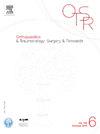Rate of complications and short-term Functional Results of Revision Total Knee Arthroplasty for Tibio-femoral Instability: do stability and range of motion are restored in 62 revisions
IF 2.3
3区 医学
Q2 ORTHOPEDICS
引用次数: 0
Abstract
Background
Tibio-femoral instability (TFI) due to ligament imbalance is a growing cause of revision total knee arthroplasty (TKA). The results are heterogeneous in the event of revision and literature is scarce regarding this issue particularly when use of hinge prostheses is not exclusive to manage this complication. Therefore, a retrospective investigation was conducted aiming to (1) analyze the one-year functional results, (2) determine the rate of complications after revision for TFI using posterior-stabilized or condylar constrained knees (CCK), 3) identify the factors that could influence the function outcome.
Hypothesis
Patients undergoing revision TKA for TFI would show an improvement in Oxford Knee Score at one year postoperative.
Methods
Sixty-two patients were included (40 females, 22 males) mean age 62,9 years ± 8.2 (range, 45,7–78,4). Instability was classified as instability in extension (n = 28), midflexion (n = 12), flexion (n = 12) or global (n = 15). Revisions were done because of isolated instability. Revision consisted in implant revision using a CCK (n = 42), a hinge prosthesis (n = 12) or an isolated polyethylene insert exchange (n = 8). Patients were assessed at one year by the difference between the preoperative Oxford Knee Score (OKS) and the score at one year postoperatively. The results were deemed satisfactory if the variation between preoperative OKS and one-year follow-up was greater than or equal to 5 points (Minimal Clinically Important Difference (MCID) following TKA). Complication rate and risk factors influencing the outcome were also analyzed.
Results
Of the 62 patients, 59 could be assessed at one year using postoperative OKS (one death at 0.66 years from unrelated reason, and two had repeated revision within one year postoperative [1 aseptic loosening and 1 Co-Cr allergy]). Preoperative OKS was 15.5 points ± 7.1 (range, 2–37), rising to 28.9 points ± 8.7 (range, 11–45) at follow-up. The mean OKS improvement was 13.4 points ± 10.3 (range, -8 to 33) (p < 0.001) and 47 patients (79.6%) reached the MCID at follow-up. Female gender was associated with a worse evolution of OKS (-5.8, 95% CI: −11.26 to −0.34 (p = 0.038)). In contrast, there was no significant difference in the evolution of the OKS according to the type of TFI in extension or in flexion, in midflexion or global (p = 0.5). Likewise, there was no significant difference in the evolution of the OKS between RTKA using CCK, hinged prosthesis or isolated polyethylene insert exchange (p = 0.3). There was no recurrence of instability at final follow-up (3.04 years ± 1.5 (range, 0.66–6.25)). Revision for instability did not drive to stiffness since mean flexion prior to RTKA was 116 ° ± 13 ° (range, 90 ° to 130 °) versus 116.7 ° ± 12 ° (range, 90 ° to 130 °) at follow-up. Fourteen patients (22.6%) experienced postoperative complications, including 3 revisions (4.8%) at final follow-up.
Conclusion
RTKA for TFI leads to significant functional improvement at one-year postoperative. However, the risk of complications is almost high at 22.6%.
Level of evidence
IV; retrospective study
胫骨-股骨不稳的翻修全膝关节置换术的并发症发生率和短期功能效果:在 62 例翻修手术中恢复了稳定性和活动范围。
背景:韧带失衡导致的胫股骨不稳定(TFI)是导致全膝关节置换术(TKA)翻修的一个日益严重的原因。翻修手术的结果各不相同,有关这一问题的文献也很少,尤其是在使用铰链假体并不是处理这一并发症的唯一方法时。因此,我们进行了一项回顾性调查,旨在:1)分析一年的功能结果;2)确定使用后稳定或髁约束膝(CCK)进行TFI翻修后的并发症发生率;3)确定可能影响功能结果的因素:假设:接受翻修TKA治疗TFI的患者在术后一年的牛津膝关节评分会有所改善:纳入62名患者(40名女性,22名男性),平均年龄为62.9岁±8.2岁(范围为45.7岁至78.4岁)。不稳定性分为伸展不稳定性(28 例)、中屈不稳定性(12 例)、屈曲不稳定性(12 例)或整体不稳定性(15 例)。翻修是因孤立的不稳定性而进行的。翻修包括使用CCK(42例)、铰链假体(12例)或单独更换聚乙烯内衬(8例)进行植入物翻修。根据术前牛津膝关节评分(OKS)与术后一年评分之间的差异对患者进行一年评估。如果术前 OKS 与术后一年随访之间的差异大于或等于 5 分(TKA 术后最小临床意义差异 (MCID)),则结果为满意。此外,还对并发症发生率和影响结果的风险因素进行了分析:在 62 位患者中,有 59 位患者在术后一年可通过 OKS 进行评估(1 位患者在术后 0.66 年因无关原因死亡,2 位患者在术后一年内再次进行翻修(1 位无菌性松动,1 位 Co-Cr 过敏))。术前的 OKS 为 15.5 点 ± 7.1(范围为 2 至 37),随访时升至 28.9 点 ± 8.7(范围为 11 至 45)。平均 OKS 改善率为 13.4 点 ± 10.3(范围:-8 至 33)(PRTKA 治疗 TFI 可在术后一年显著改善功能。然而,并发症的风险几乎高达 22.6%:证据等级:IV;回顾性研究。
本文章由计算机程序翻译,如有差异,请以英文原文为准。
求助全文
约1分钟内获得全文
求助全文
来源期刊
CiteScore
5.10
自引率
26.10%
发文量
329
审稿时长
12.5 weeks
期刊介绍:
Orthopaedics & Traumatology: Surgery & Research (OTSR) publishes original scientific work in English related to all domains of orthopaedics. Original articles, Reviews, Technical notes and Concise follow-up of a former OTSR study are published in English in electronic form only and indexed in the main international databases.

 求助内容:
求助内容: 应助结果提醒方式:
应助结果提醒方式:


